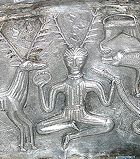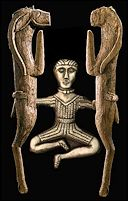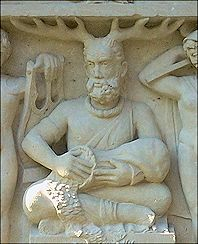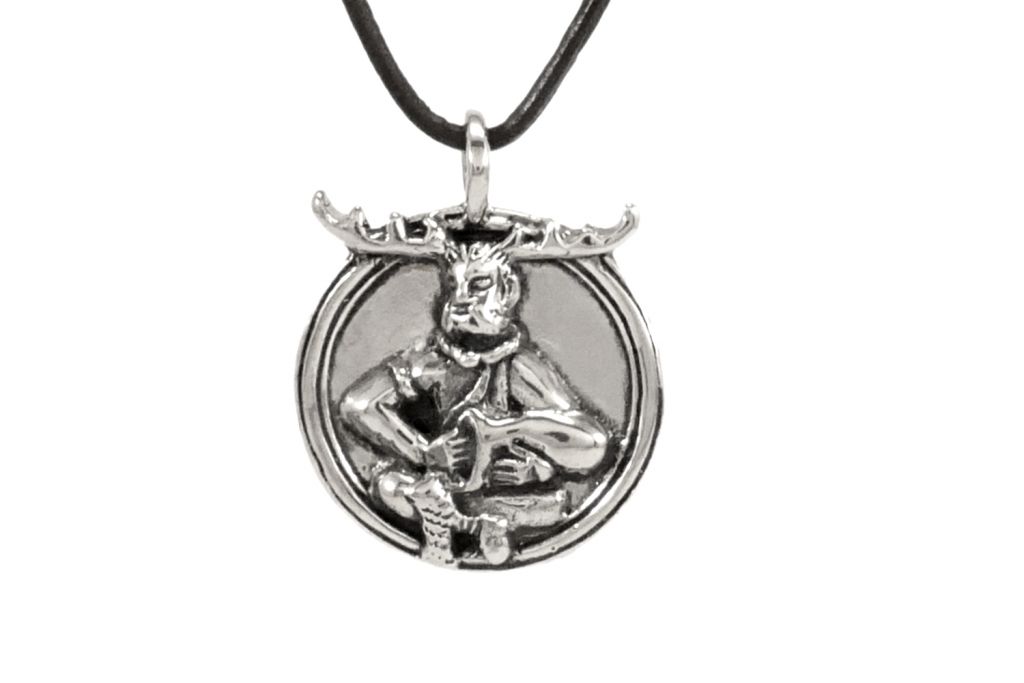Cernunnos Pendant, Silver
Cernunnos is here shown in the famous posture with crossed legs, wearing a torques (neckring). On his knees he carries a bag, Cernunnos distributes his gifts for the animals of the forest.
Cernnunos - Our Pendant
Cernunnos is here shown in the famous posture with crossed legs, wearing a ring on the right upper arm and a torques (neckring). On his knees he carries a bag, Cernunnos distributes his gifts for the animals of the forest. The motif is inspired by a Gallo-Roman sacrificial stele from Reims. The Cernunnos amulet has a diameter of approx. 25 mm. It is handcrafted of solid 925 silver and will be shipped with a leather thong and a certificate.
Cernunnos - A Celtic God
Unfortunately the Celts left nearly no writings, inscriptions or literature, that could help us with the reconstruction of the Celtic beliefs. However, it is sure that faith and superstition were so strong, that even people and most valuable consecration gifts were sacrificed.
Depictions of celtic gods, like at the plates of the cauldron from Gundestrup, are a window into the past, which give us valuable insights. Again and again we encounter the representation of a God with deer antlers, which by inscriptions is called Cernunnos or the Latinate variants of Cernenus, cornutus or Cornunus (from the Cornu, the Horn).

Gods with deer antlers appear already since the early stone age and also can be found in other Indo-European cultures. The prehistoric cave paintings show horned shamans or gods, most likely relating to hunting rituals. Also Cernunnos is the God of the forest and the animals. He is their protector and guardian, he will bring fertility and prosperity. On the cauldron from Gundestrup, which is dated mostly to the 1st century BC, he holds a torque (neckring) and a snake in his hands. Cernunnos is surrounded by a deer, wolves, birds, and other mythical creatures.
The wooden figures of two goats and a deer, found at the celtic settlement of Felbach-Schmieden, originally belonged to a cult image, which also comprised a human figure which is unfortunately not preserved. Here, one can assume a depiction of Cernunnos, too.
Horned creatures, ghosts and heroes are known from numerous myths and legends of the middle ages. Just from the rich treasure of Irish mythology, memories of the ancient Celtic God seem to be preserved.

Hypothetic reconstruction of the cult-figures
of Fellbach-Schmieden
Gods with deer antlers appear already since the early stone age and also can be found in other Indo-European cultures. The prehistoric cave paintings show horned shamans or gods, most likely relating to hunting rituals. Also Cernunnos is the God of the forest and the animals. He is their protector and guardian, he will bring fertility and prosperity. On the cauldron from Gundestrup, which is dated mostly to the 1st century BC, he holds a torque (neckring) and a snake in his hands. Cernunnos is surrounded by a deer, wolves, birds, and other mythical creatures.
Cernunnos - the Gallo-Roman Votiv Stele of Reims
Even after the conquest of Gaul by the Romans, the old belief in Cernunnos as the God of animals and forests is not extinguished. Pictures on votiv stones are dated far into the roman age. In contrast to other celtic deities he is not a victim of the Interpretatio Romana and was not equated with any classical Roman God.
At the stone from Durocorturum (today´s Reims) of the 1st century AD, which inspired our Cernunnos pendant, the antlered god is accompanied by Apollo and mercury. Cernunnos is the centre of the votiv stele, and he pours out water or cereal out of a bag, to feed a bull and a deer. I think, a proposed interpretation of coins as a symbol of wealth and prosperity instead of water is rather unlikely.

Cernunnos - Literature and Informations
Michael Altjohann: Cernunnos-Darstellungen in den gallischen und germanischen Provinzen. In: Peter Noelke (Hrsg.): Romanisation und Resistenz in Plastik, Architektur und Inschriften der Provinzen des Imperium Romanum. Neue Funde und Forschungen. Philipp von Zabern, Mainz 2003. S. 67–80. ISBN 3-8053-3089-8.
Bernhard Maier: Lexikon der keltischen Religion und Kultur. Kröner, Stuttgart 1994, ISBN 3-520-46601-5.
| Delivery time | 1-2 weeks |
|---|---|
| weight | 0.200000 |
| size | 25 mm |
| Era | Celts |
| Material | Silver 925 |
| Kind of replica | Pendants |
| scope of delivery | Delivery in a jewellery case with leather necklace and certificate |

